My friend Ross Devenish sent me this quote from Travels with a Donkey in the Cèvennes :
“Why anyone should desire to go to Cheylard or to Luc is more than my inventing spirit can embrace. For my part, I travel not to go anywhere, but to go; I travel for travel’s sake. And to write about it afterwards, if only the public will be so condescending as to read. But the great affair is to move; to feel the needs and hitches of life a little more nearly; to get down off this feather bed of civilisation, and to find the globe granite underfoot and strewn with cutting flints.”
Robert Louis Stevenson
“I’m uncertain about leaving the ‘feather bed’ but the sense that you just want to go, rings a bell with me,” Ross added!
I agree.
I’m not sure either about the ‘cutting flints’ though I did succeed in dropping and shattering very impressively, a bottle of Canada Dry Tonic Water in the supermercado yesterday and promptly created a bloodbath when glass got into my foot!
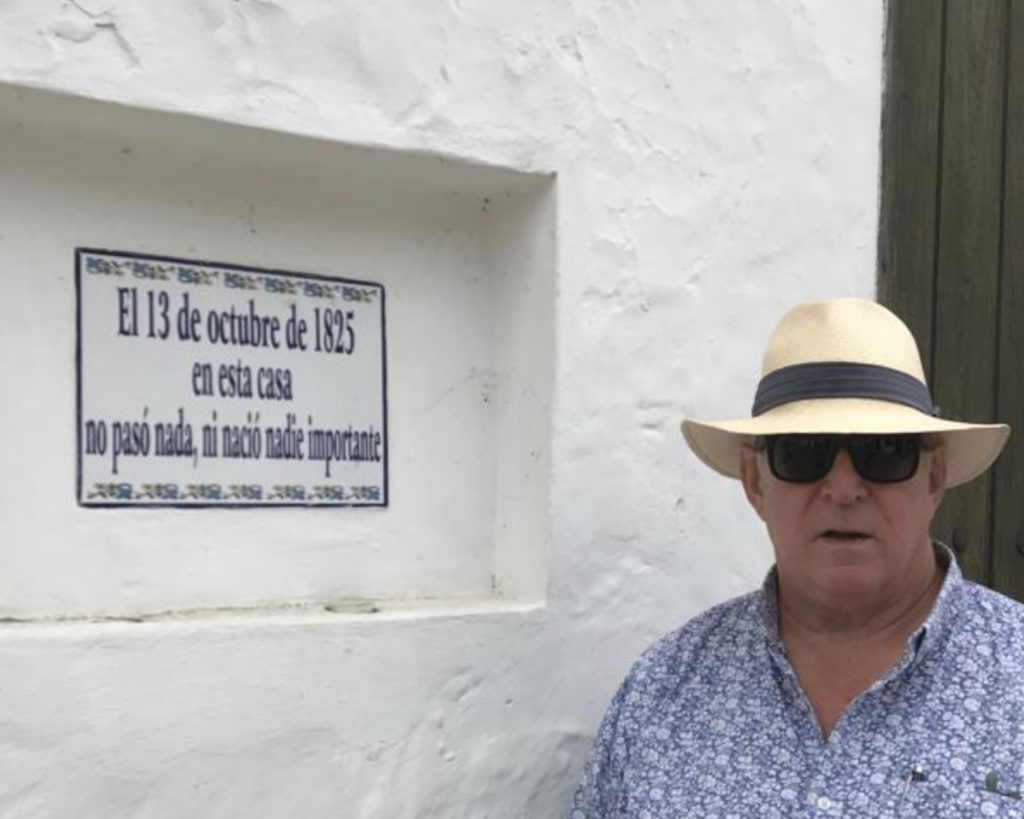
With all the visits to museums and houses and burial grounds and tombs and the whole ritual of the tourist abroad, it was refreshing to find this wonderful tile outside one or other of the sites. It is almost an admonishment!
On the 13th December, 1825, in this house nothing happened and no-one important was born.
Mesitas del Colegio
Richard came to live and work in Colombia back in the late 1980s. He taught maths to the sons and daughters of wealthy Colombians, in English, at the Colegio Anglo Colombiano, considered one of the elite schools.
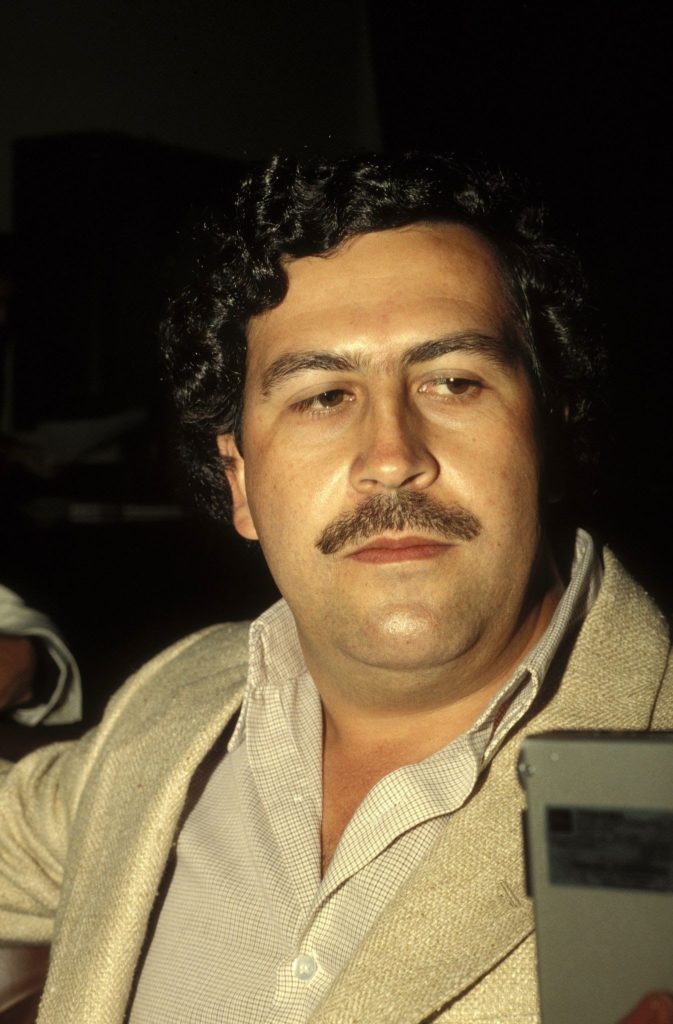
He was here during the era of the Muerte a Secuestradores or MAS, essentially a terrorist organisation set up by Pablo Escobar to corrupt the system with protection rackets and extortion. There were many murders, planes blown up and high profile kidnappings. Richard was teaching at the time of the invasion of the Palace of Justice in La Candelaria and urged to stay clear of the area. About nine justices were murdered, tanks invaded the building and cared not a jot for the deaths they caused among the many innocent present. The building was set alight. There was mayhem. Those extracted from the blaze were never seen or heard of again.
Richard met José Mosquera during these times. They became friends. José now has a beautiful home, to which he and his partner Hans-Peter Balle come every English winter and which is generously shared with friends and which is also home to sister Doris and brother Carlos and three beautiful dogs, Shakira, Zeuss and Max. It’s name is Finca Pradera. We were made very welcome.
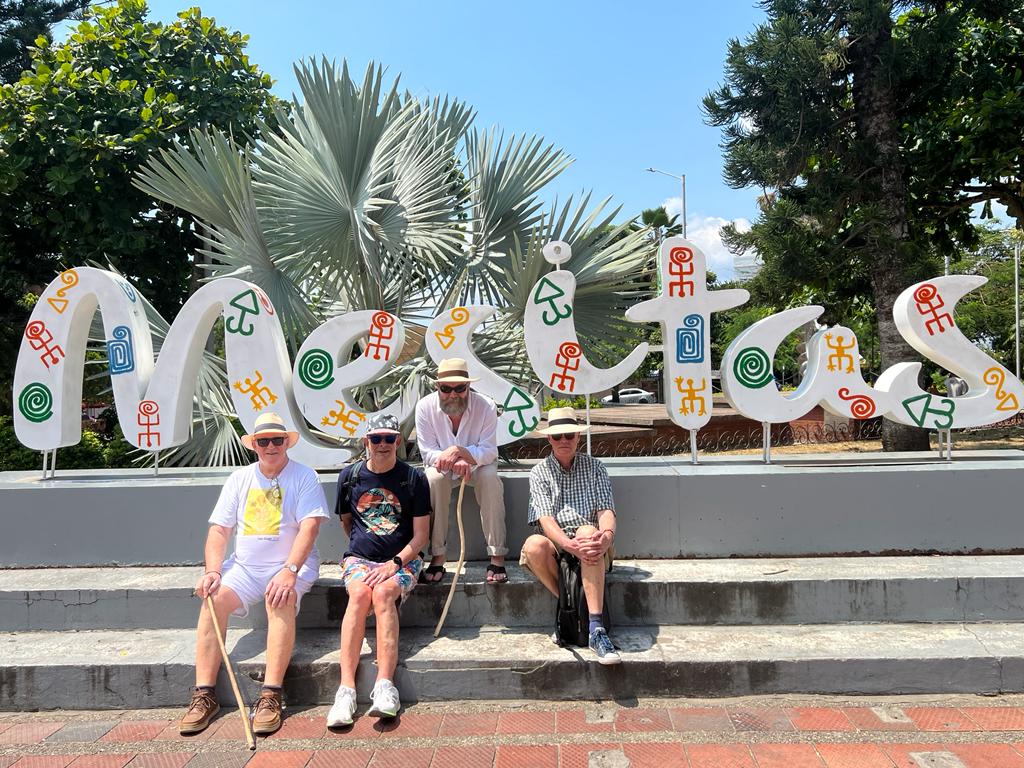
So, from Villa de Layve, Baudilio drove us down the Rio Bogotá valley through the traffic insanity of Bogotá itself, clogged with fumes and smells from the river, down the steep escarpment, dropping 5,400 feet to Mesitas del Colegio (Cundinamarca) 2.5 hours south west of Bogotá where this little paradise is situated.
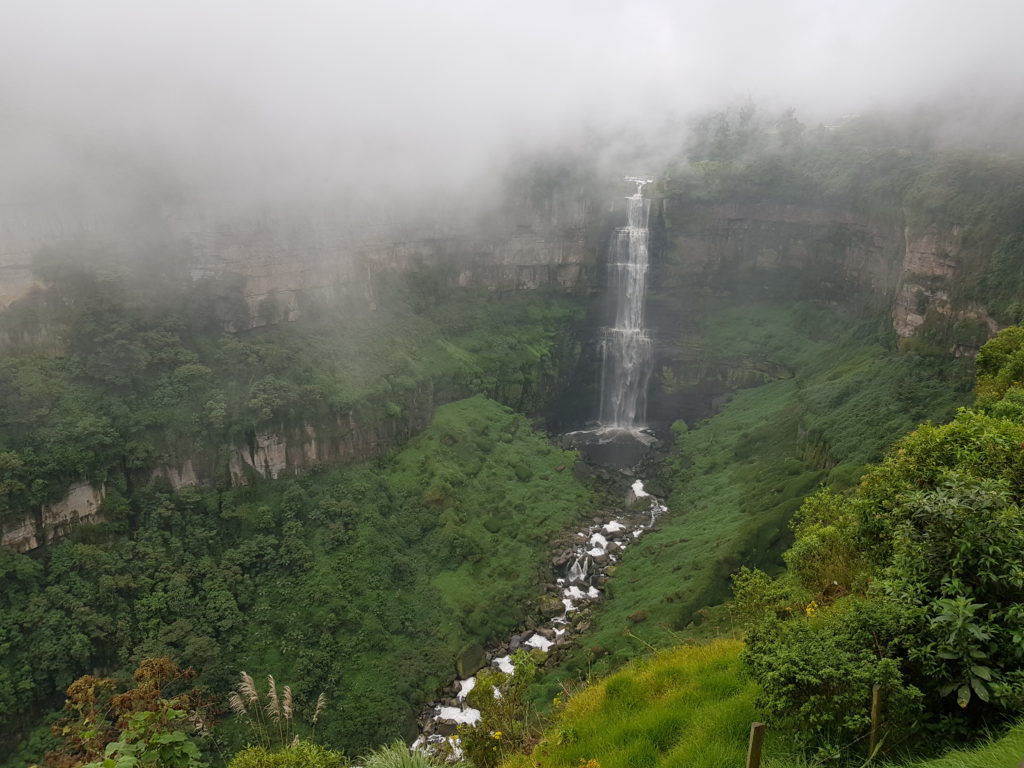
For five wonderful days we were royally treated. José is a superb cook and introduced us to many traditional dishes and others besides. The garden is rich in every conceivable fruit you can imagine and the Jugos flowed. This climate in these latitudes, on this soil just produces an endless variety of flowers, fruits, tubers, maize and beans. Chickens peck about and there are fresh eggs every day. It is genuinely a little Garden of Eden.
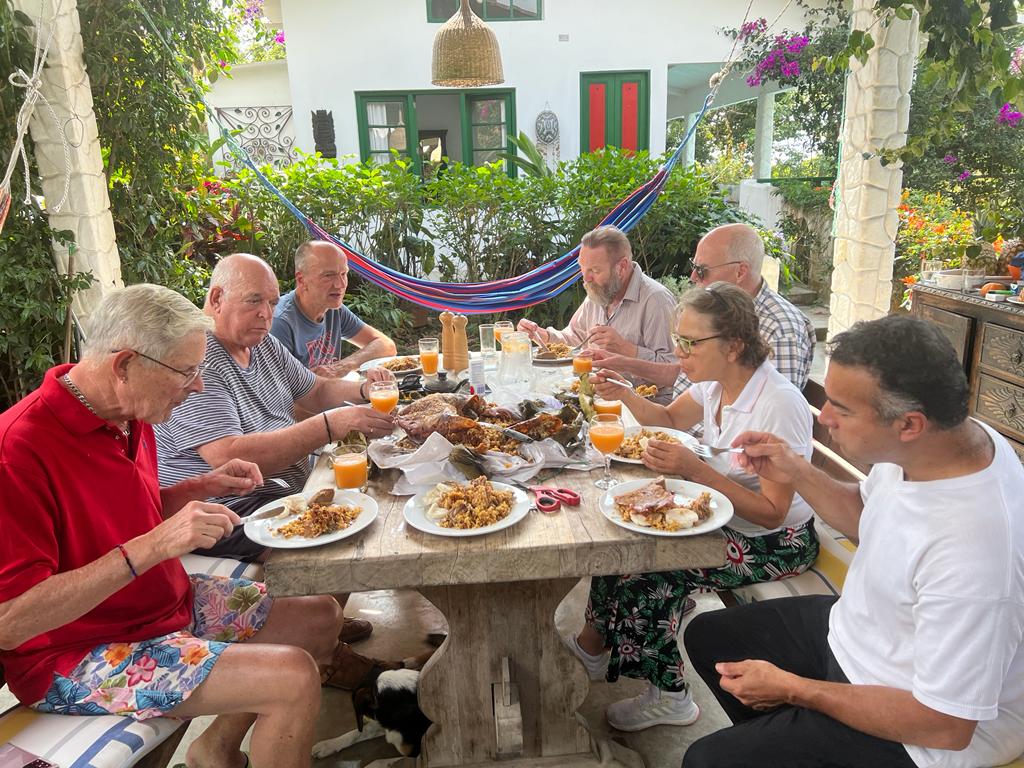
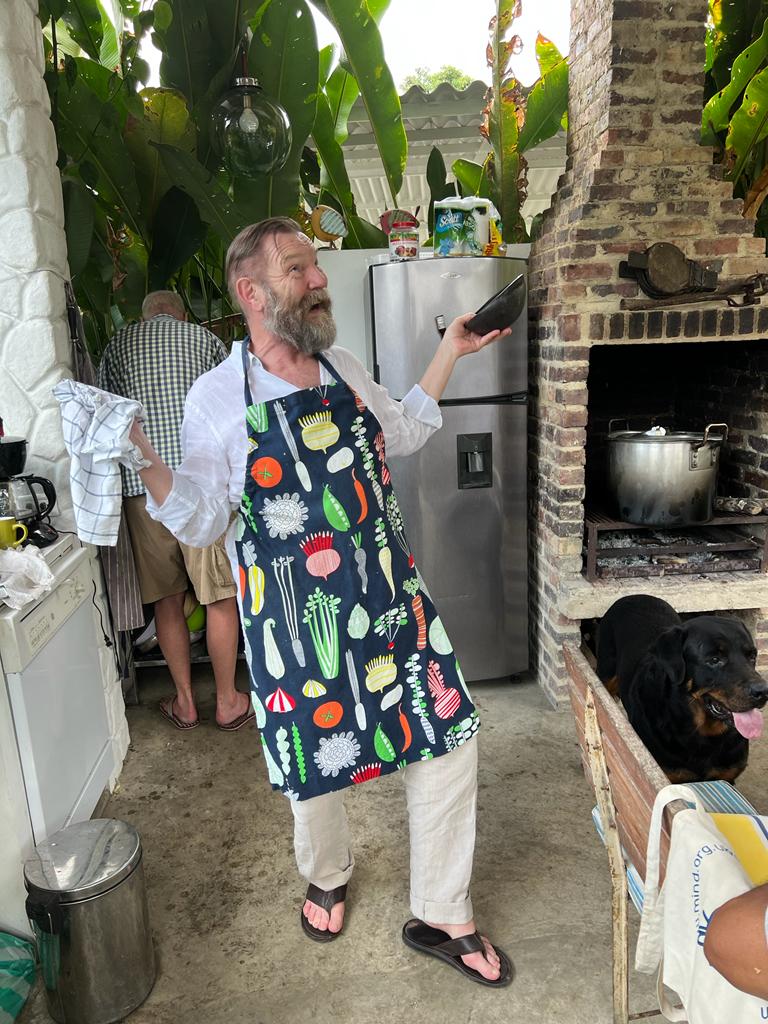
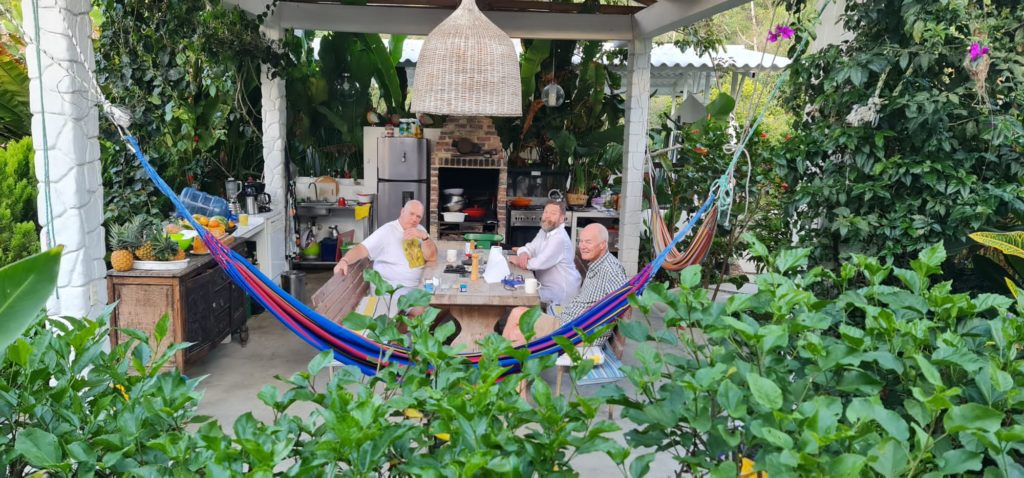
There is a pool too, who could ask for more, and we were shown around the plateau, taken into Mesitas and across the valley to La Mesa. Baudilio came from Bogotá a day early to fetch us and especially to drive us all on a massive circuit to Anapoima and La Mesa, swooping down the valley and up the other side on the return to Finca Pradera.
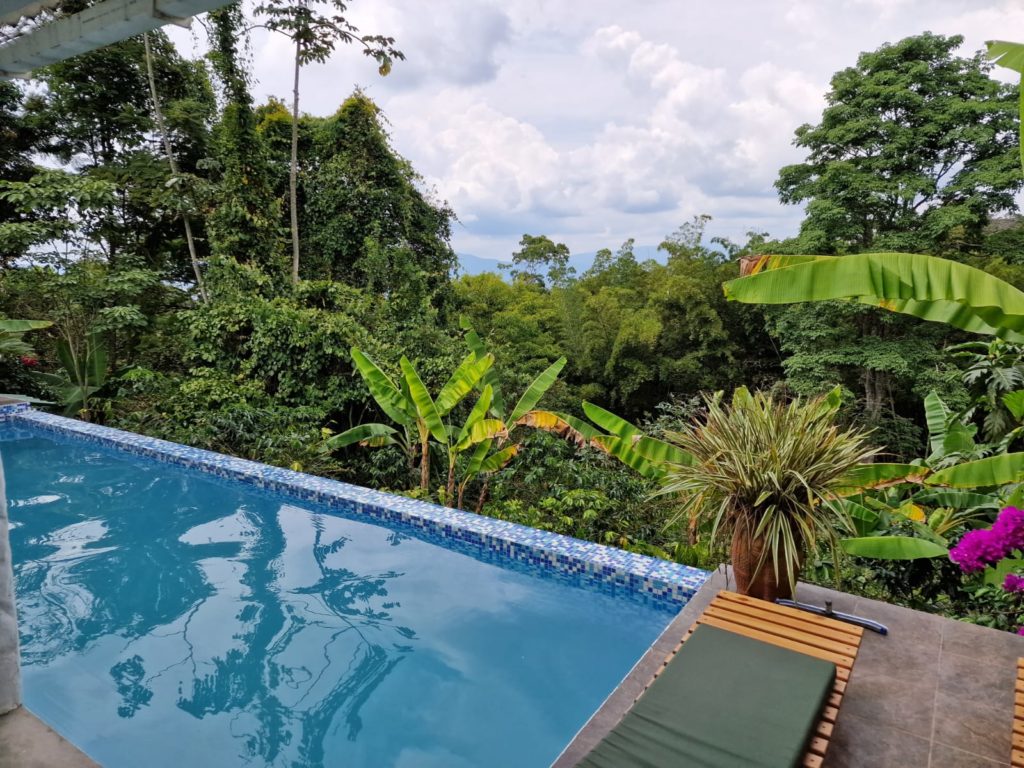
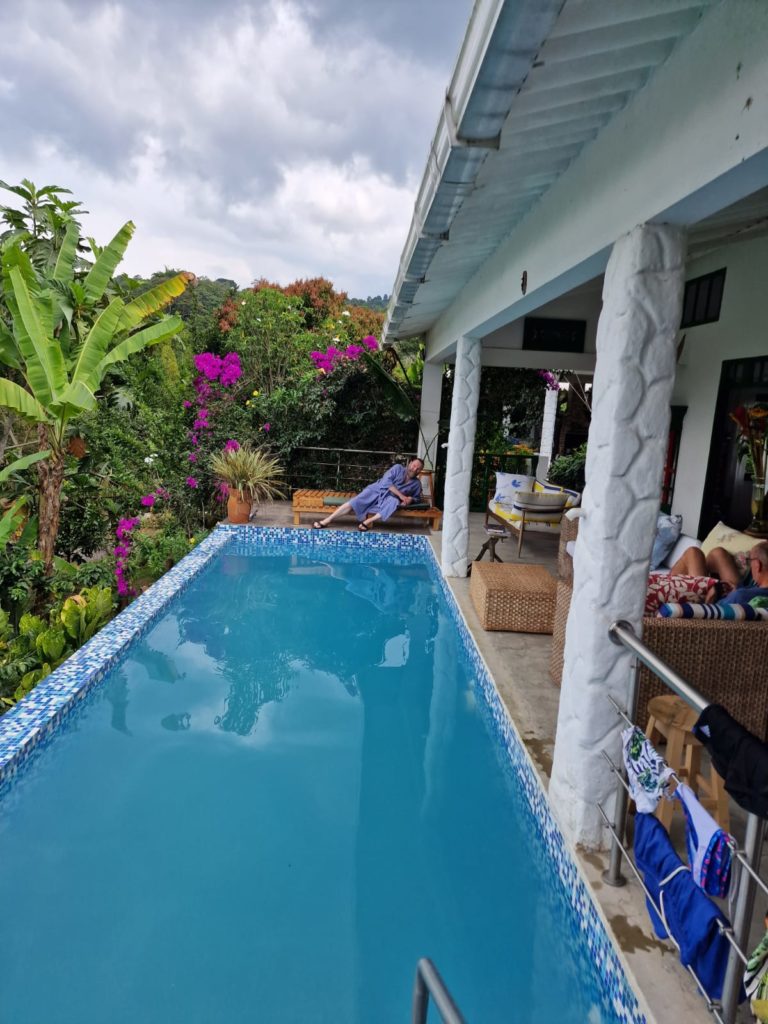
Thank you friends for making us so welcome in your beautiful home. We especially hope that Shakira’s injured leg has by now healed and we look forward to seeing you in Cartagena – and London too.
Baudilio drove us to Bogotá on our last day, for our flight to Cartagena where we picked up our rental for the next stage:
Santa cruz de Mompós (or the disease-sounding Mompox as it is called!)
The road to Mompox from Cartagena started with promise but soon reminded us of the San Agustín to Popayán odyssey. To be fair, this time the distance was 329 kms though we cheated slightly by stopping the night at Turbaco, itself only a 25 km drive from the airport where we had picked up our rental, a Renault Duster into which we managed, just, to squeeze us and all our luggage. From Turbaco the next morning it took us nearly six hours to this enigmatic, magical town in the middle of the vast marshlands through which the Rio Magdalena, now miles wide, presses. It is hot and humid. 35°C on average but feeling like 40°C. Barely a breeze.
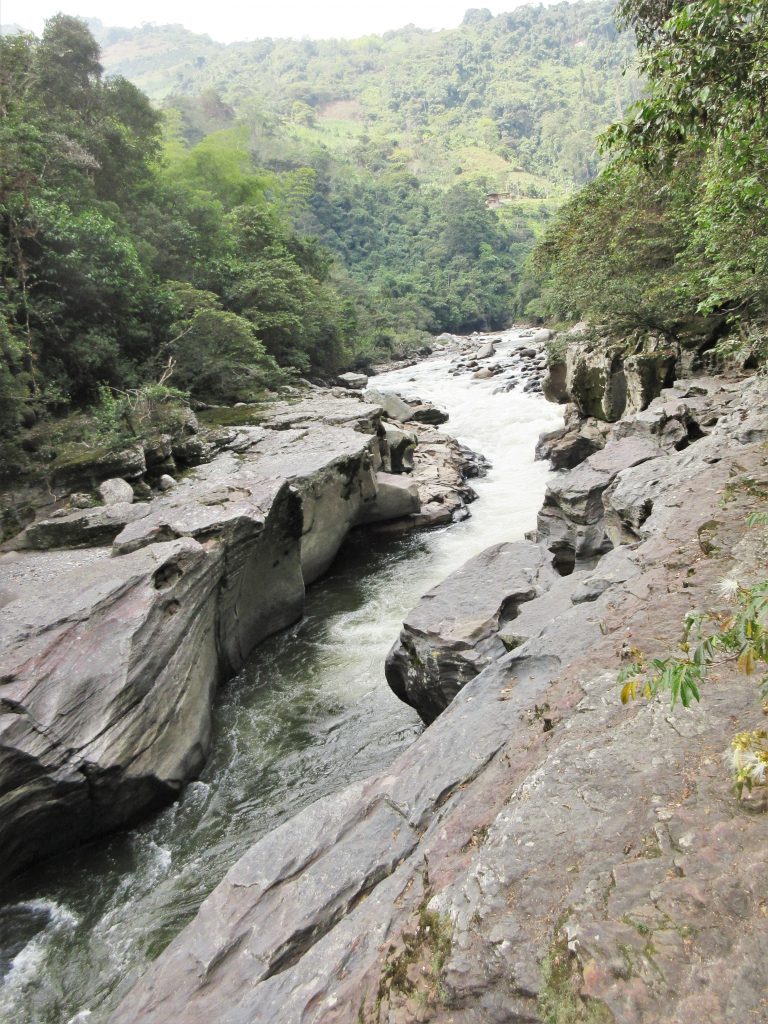
We last saw the river from San Agustín and visited a point down in the gorge where it was only a few feet wide. Way downstream from here, at Girardot, the Rio Bogotá joins the Rio Magdalena swelling it mightily but very dirtily.
When we were driving from Villa de Leyva to Mesitas we picked up the Rio Bogotá when it was a crystal clear stream cascading down the valley. When it reaches the city everything is thrown into it and it becomes disgusting despite all the efforts of a corrupt political class to clean it up.
You can jump across The Rio Magdalena up in San Agustín!
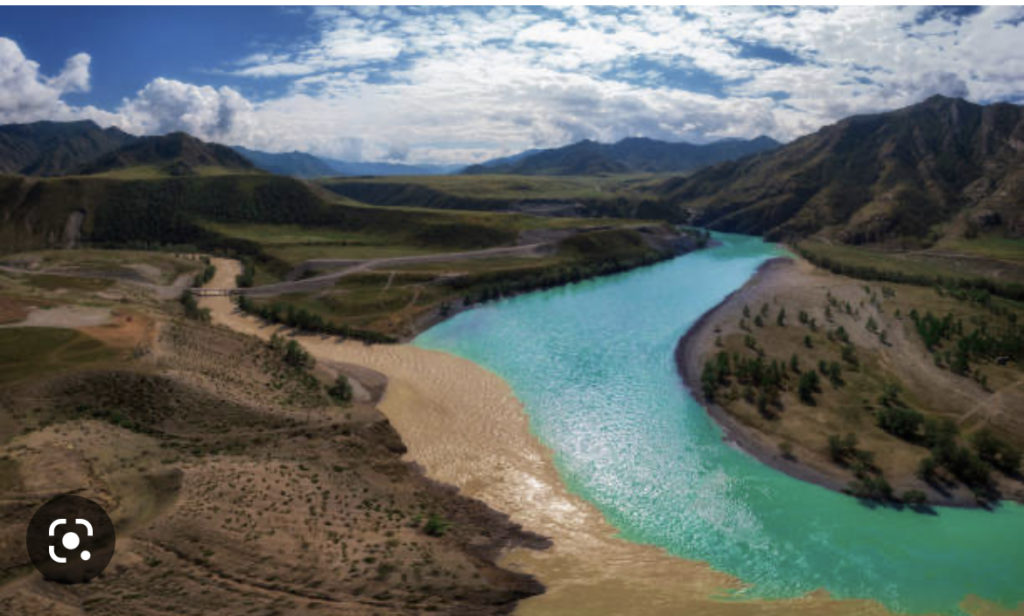
So, I shudder to think what is flowing past us here in Santa Cruz de Mompós though all the locals swim in it, all the fish we are eating comes out of it, all the thousands of Brahman cattle graze in, on and around it, all the local produce, the yuca, maize, plantains and the rest comes out of it; it teams with iguana, howler monkeys, electric eels – apparently lethal – and the most fantastic bird life of every size and colour. Further upstream Pablo Escobar’s Hippopotami are thriving after their release from his private zoo though we’ve not glimpsed them!
The first thing that crossed my mind was how on earth did those Conquistadores manage to navigate up this vast river with its myriads of channels in their 16th Century ships, the current against them, barely a favouring breeze and then establish a foothold on the banks where there is nothing except excruciating humidity, flat as far as you can see, and mud, mud glorious mud. They had armour can you believe and were dressed in Spanish clothing of the day; they’d come a long way; two-thirds were wiped out by diseases and yet here is the proof of their persistence – Mompox, this little gem of a town built of brick in the Spanish Colonial Baroque style, whitewashed walls, terracotta roof tiles, wrought iron grills over glassless windows for it is far too hot to close anything here. The slightest breeze is a gift.
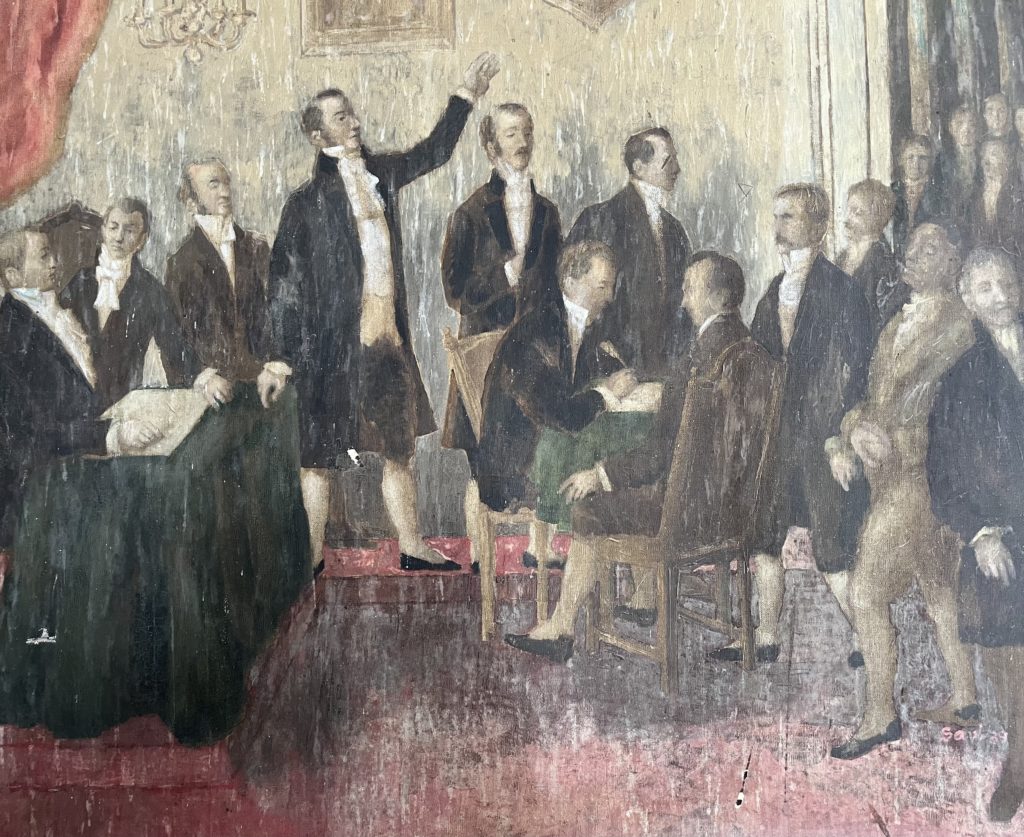
Simón Bolívar started the independence process in Mompox with 400 men. Here are the leaders of the revolution signing the Act of Independence of the 6th August, 1810 in the Casa Germán de Ribón, now the fascinating Casa de la Cultura. But look at their clothes! No concession whatsoever to the humid heat! We stood in this very room wearing shorts and slipslops!
What drove these people? El Dorado? The greed for gold? Loyalty to a faraway King and Queen? Discipline? Fear? Faith? Or were things so awful at home that anything offered abroad would be a happier option?
I suspect a little of all these but nothing detracts from the wonder that they bothered.
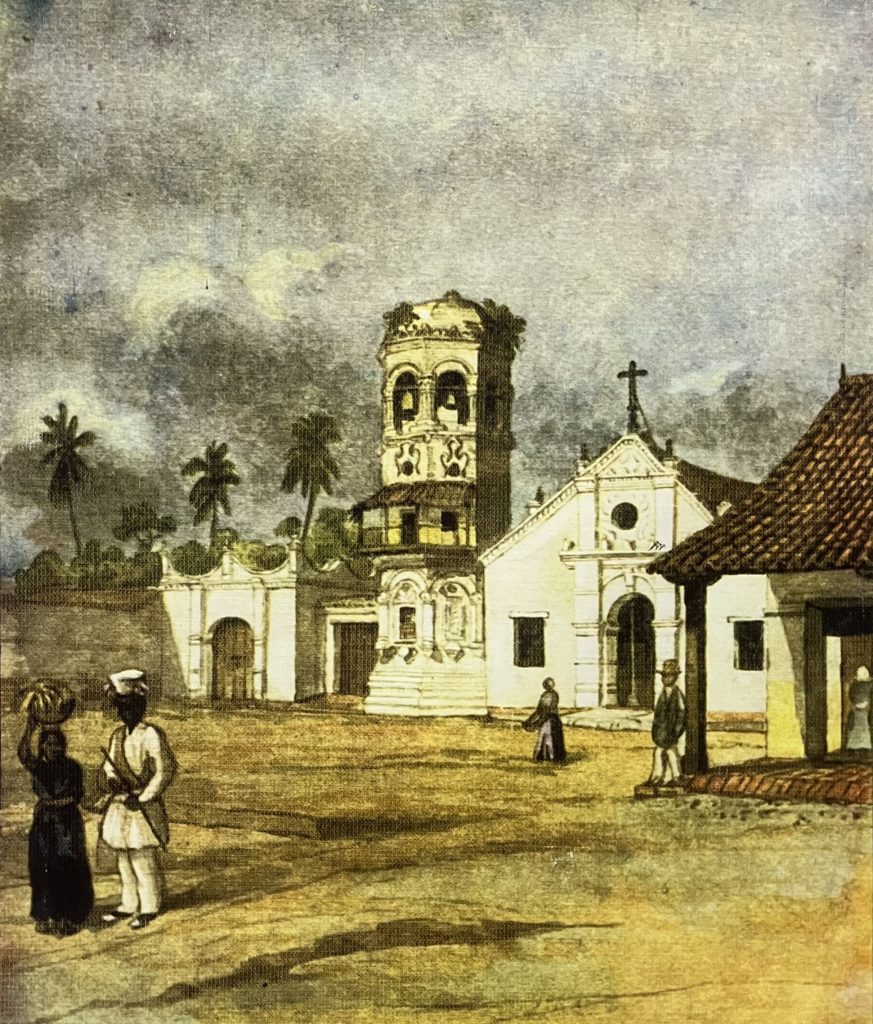
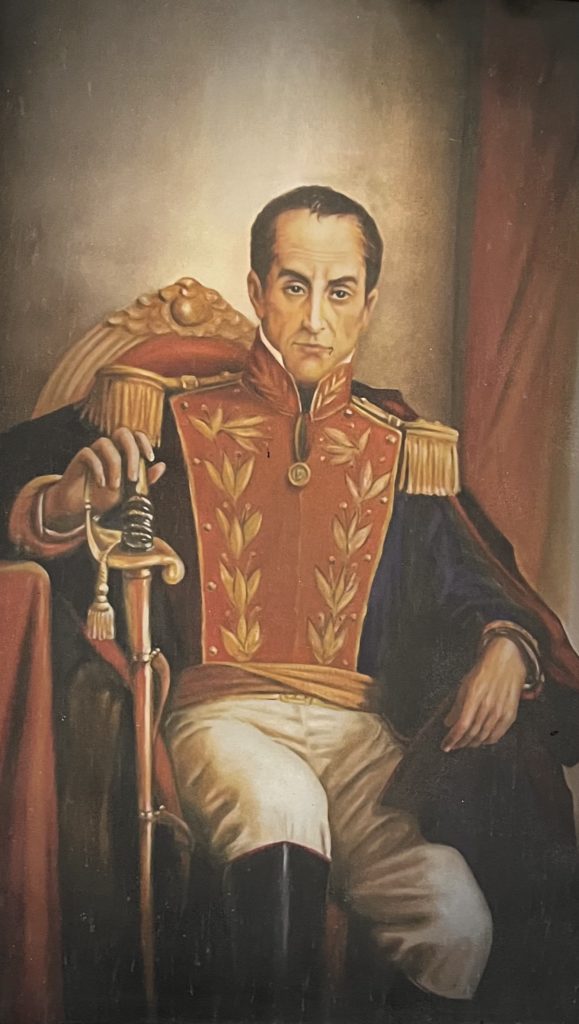
The Plaza Santa Barbára next to our hotel, not much changed and here is Simón Bolívar looking a little like David Suchet
“Does the clock stand at ten—to-three? And is there air-conditioning for tea?” “Sorry, air-conditioning’s off dear!”
And it was! There was a power cut and our rooms at the San Rafael Hotel were like ovens. Thank heavens at 5pm everything whirred into action though it took several hours before caliente became frio.
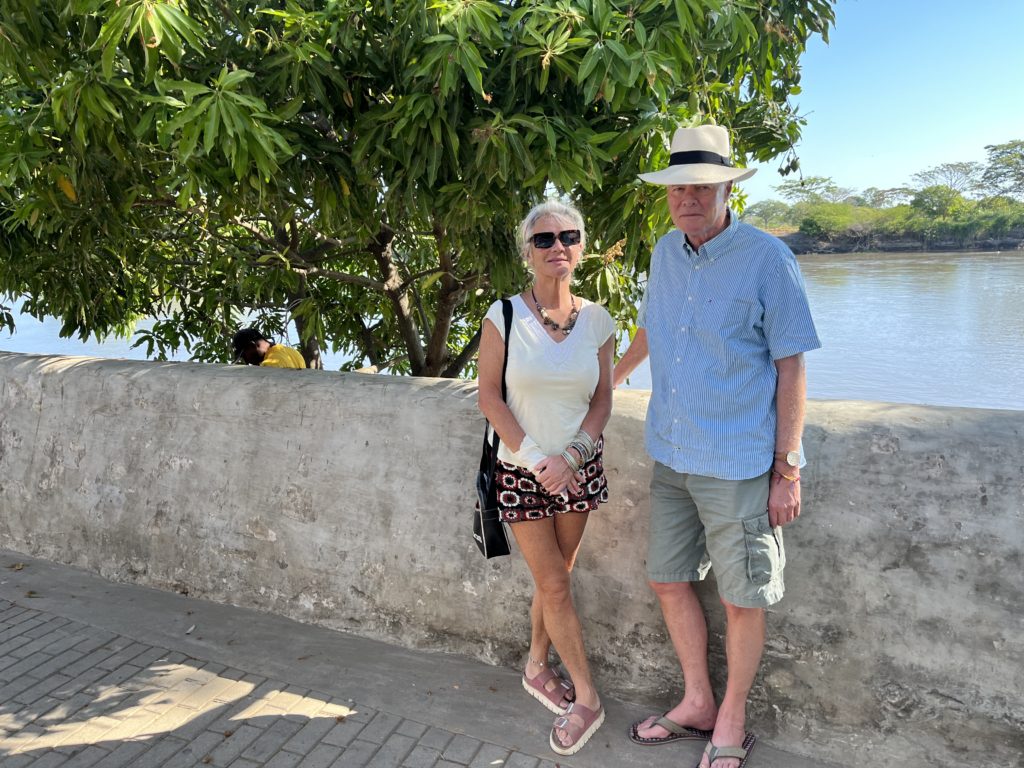
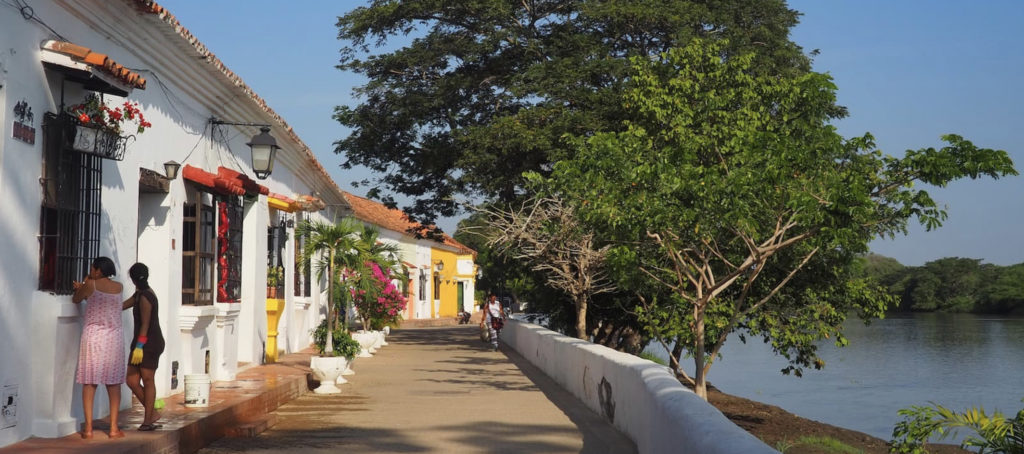
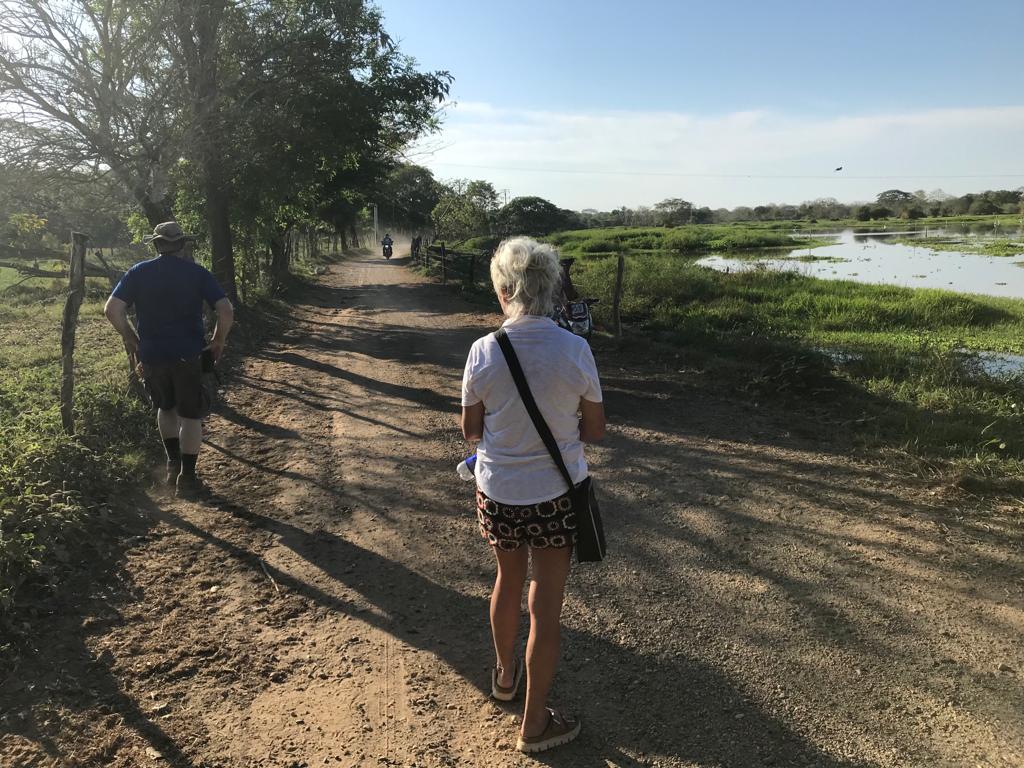
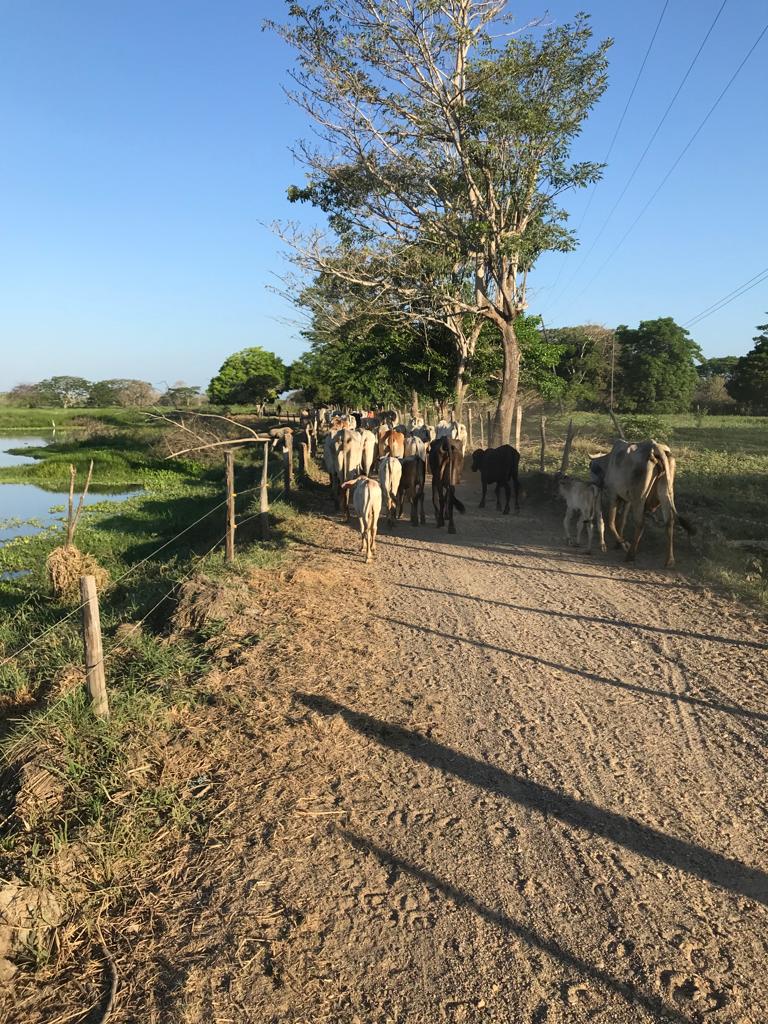

Outside the San Rafael Hotel on the Albarrada. Best walks are early in the morning when it is cooler. A small ferry for a few cents can take you across the river where the farms and small holdings hint at a simpler life. Tony is with Sara Wheeler.
Our hotel is right on the river front in a beautiful line of old palaces, homes and warehouses that were part of this entrepôt all those years ago. Now making up a collection of boutique hotels, bars and restaurants, the rebuilding and rapid renovation is reviving the fortunes of this faded town.
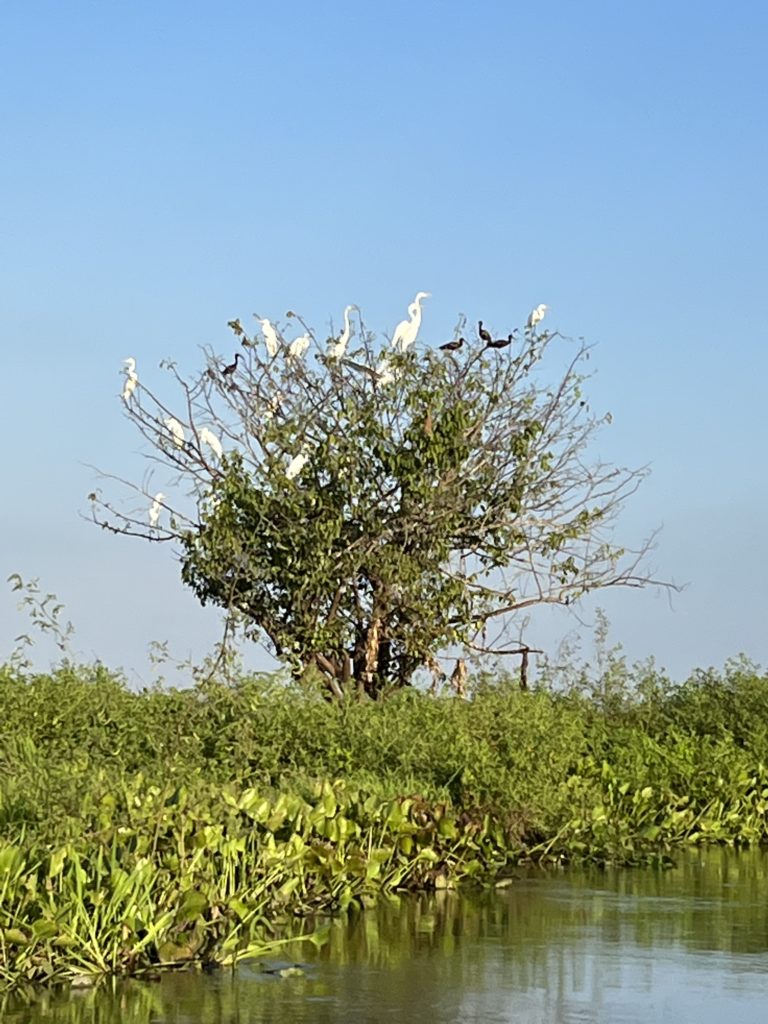
Yesterday we embarked a flat bottomed river boat belonging to Freddie who guided us for several hours through the waterways and smaller channels that criss cross this vast ecosystem. How Freddie knew where we were and often in alarmingly shallow water, I’ll never know. He pointed out many things, birdlife, iguanas, monkeys and small communities living simply on the impenetrable banks scraping existences from farming, fishing and market gardening. Freddie assured us that we were safe and that he trusted his Johnson Outboard motor to bring us through.
No Evinrudes, Yamahas or suchlike for him he declared in Spanish rather enigmatically.
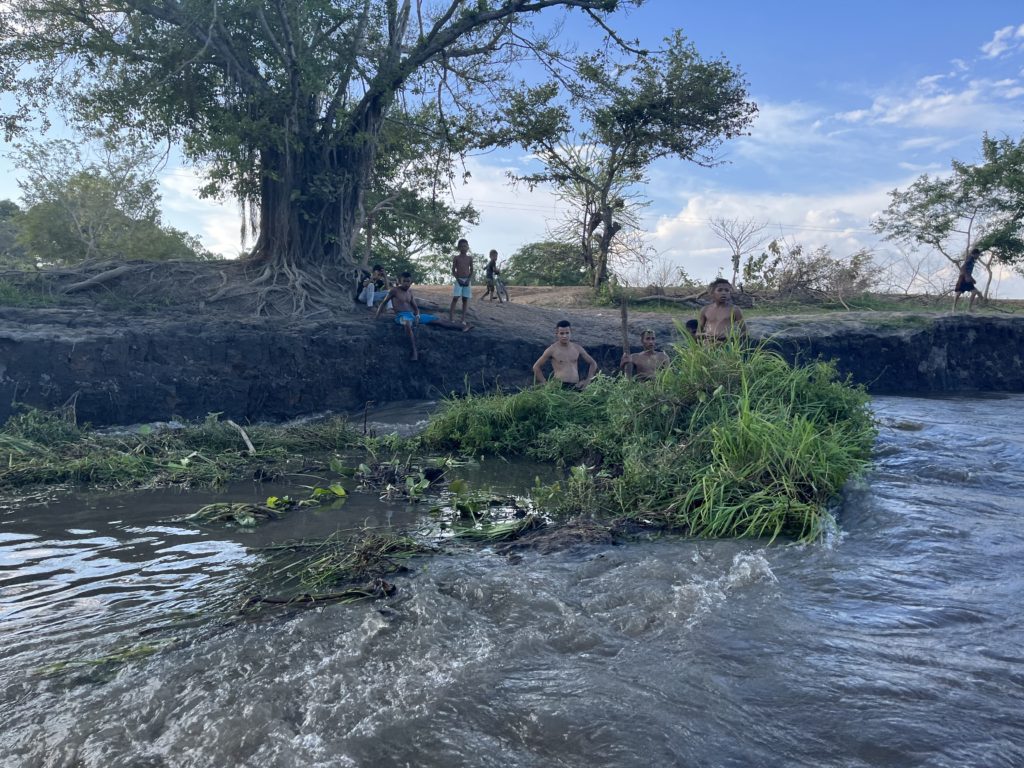
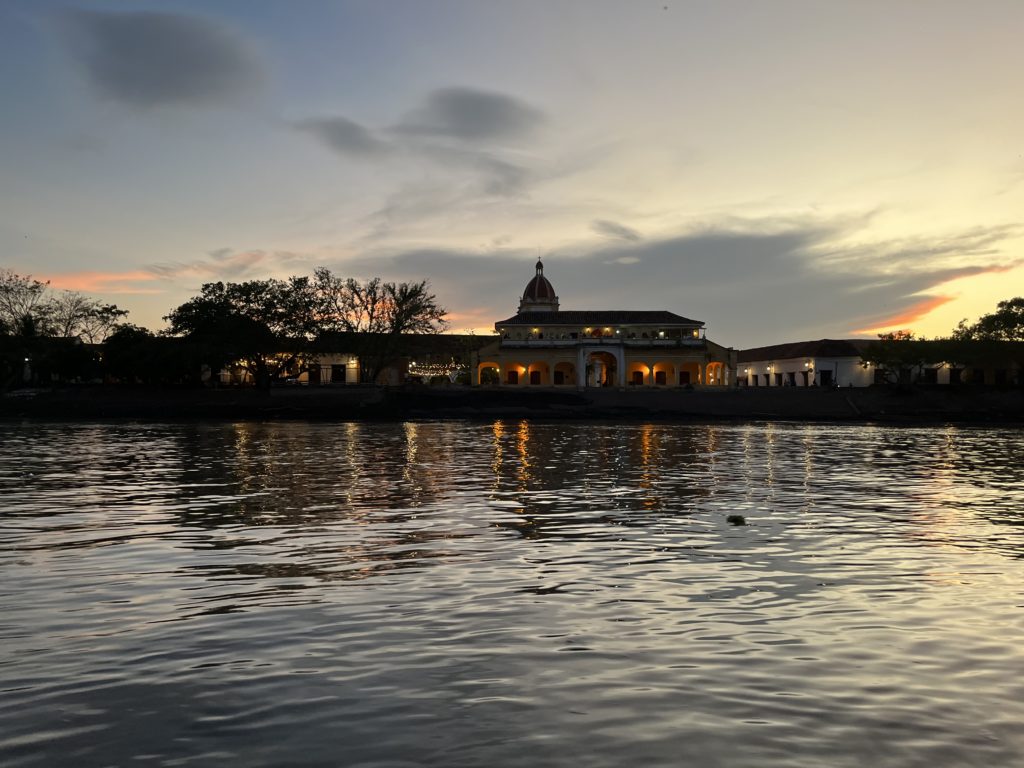
We returned to the hotel as the sun set over the river in that fast way it always does in the tropics.
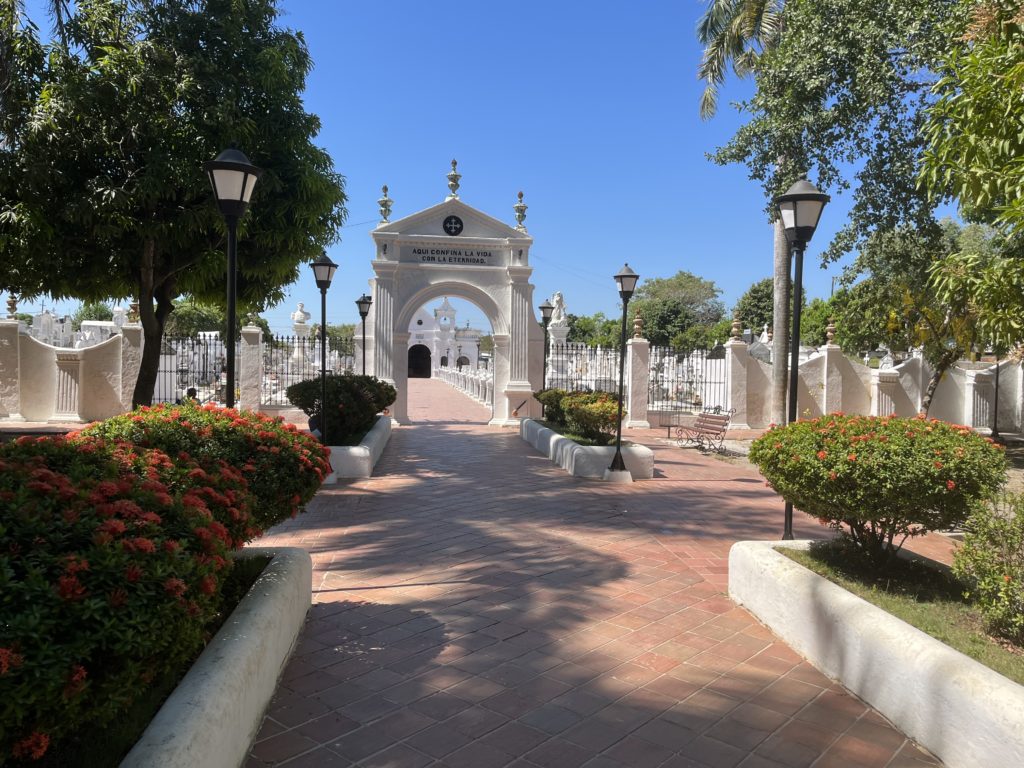
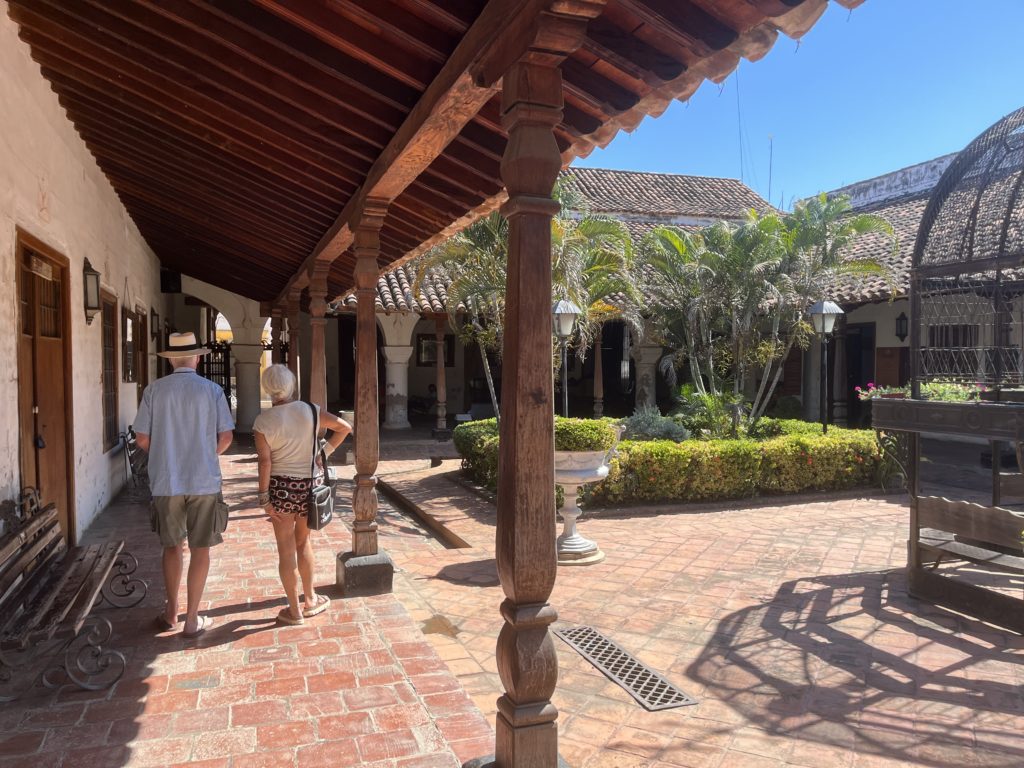
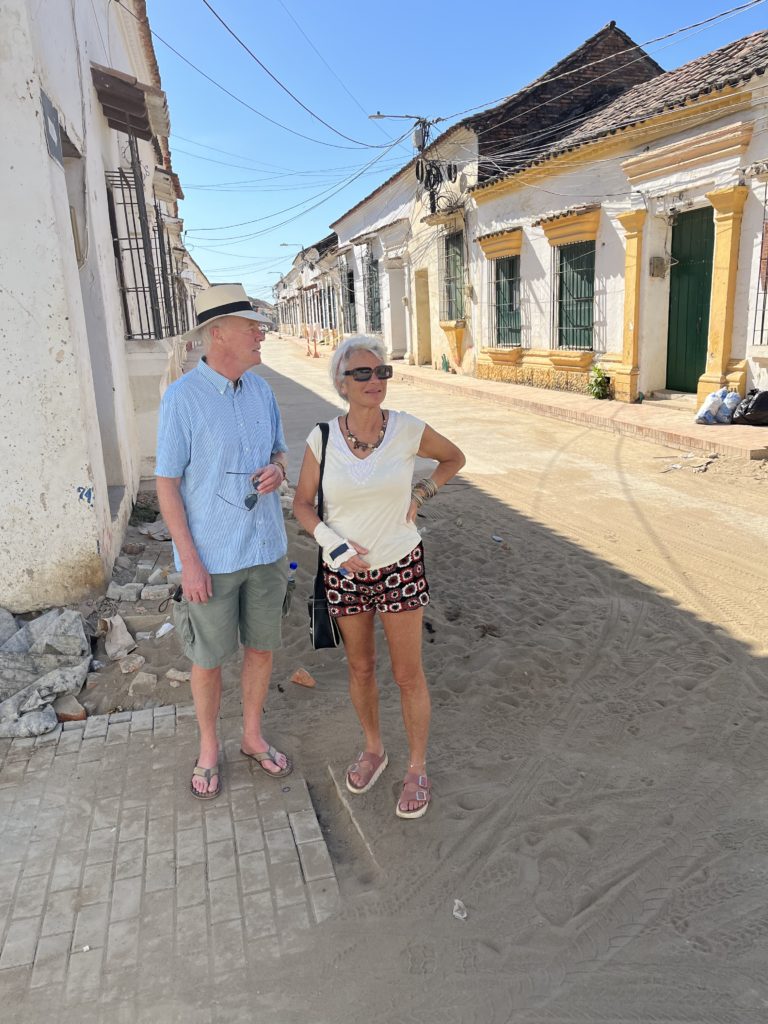
The Cemeterio Municipal and the Casa de la Cultura, an original building.
Our friend, Travel Writer Sara Wheeler is here and we have enjoyed her company very much. Her book Travels in a Thin Country all about Chile, is one of my favourites. She recommended Wade Davis’ Magdalena: River of Dreams which we found and downloaded to our Kindles. It looks fascinating and now joins a queue. She and Tony visited the extraordinary forgotten theatre of Mompox, the once grand Teatro Colonial, built in 1942 and abandoned more than twenty years ago, its roof partially collapsed and its faded grandeur now home to several, squatting local families. It’s a totally bizarre, crazy looking place, with home comforts lodged in between the old balconies.
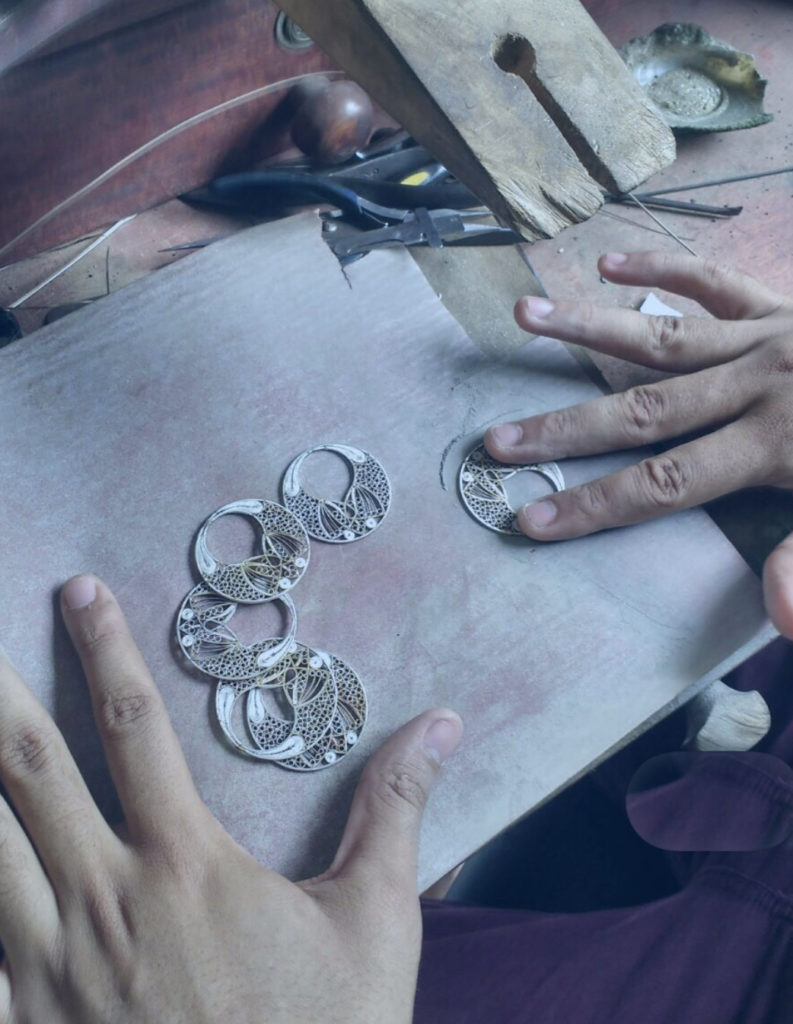
Mompox Silver was interesting: blending Spanish, indigenous and Arab techniques there is a long tradition of silver craftsmanship here and along the Calle Real del Medio there are many workshops showing these techniques and offering some beautiful pieces for sale.
Lent has come round again in the Catholic Calendar and every town has its Carnival – not least Mompox where the local rhythms pumped out over excited crowds all dressed in impossible costumes and spraying foam over everyone from long cylindrical cans.
We spent almost an entire week here. At first we thought that too long but in fact once we had been lulled into the slow pace induced by – and got a little more used to – the heat and humidity it turned out to be a good choice. We loved it here.
Time to pack up the car and drive back to Cartagena de Indias for our last week here.
I have been thinking so much about my dear, late brother David. He and I stopped off here on our way through the Panama Canal, on the Celebrity Infinity out of Miami, fetching up in San Diego, just three years ago. With his compromised health he was unable to disembark in Cartagena and decided to conserve all his strength for the main event – the Canal. I have been reading my diary. I went ashore on my own:
“Cartagena is a beautiful city, at least the tiny part I saw. Of course you are given very few hours to explore these ports we visit; but enough in this case to encourage another, longer visit at some other time. The city was of vital importance to the Spanish political and economic control of its colonies here. It is one of the oldest. It is dominated by an impressive fortress, San Felipe Barajas, and the Old Town is surrounded by a ten kilometre wall. The natural harbour is beautiful. It is made up of a maze of islands and large bays and inlets. Beyond the Old Town is the New which is reminiscent of Miami. There are wonderful beaches and it is a tourist paradise! Well, I only had time really for a good wander through the Old Town and the Barrios, after the obligatory visit to the Fort. No time even for the Convent occupying the highest point over the city; a look in at the creepy Inquisition Museum on what is now S. Bolivár Square – a sort of early Lubyanka you might say, except it was religious commissars who undertook the purgings. Time too for some churches and the impressive Monesterio de Pedro Claver, redeemer of slaves and now a saint. Before long we had to return to the ship in a torrential tropical downpour. It was hot and humid and the air conditioning was a welcome relief; but I definitely want to come back here.”
And I am back here, with Tony this time, for nearly a week. Tarry Tours have put up on the Bocagrande in an AirBnB at Palmetto Beach. One of a forest of shimmering white skyscrapers, we occupy a three bedroom apartment on the 15th floor with spectacular views towards the Centro Histórico; the beach is across the road and there is a swimming pool on the rooftop, floor 38.
We have been keeping up with various museums of course, and also re-visited (for me) the Museo Histórico once the Palacio de la Inquisition and the Santuario de San Pedro Claver whose actions partially off-set the appalling policies of the Catholic Church and its main instrument of terror here, The Inquisition. Don’t get me started.

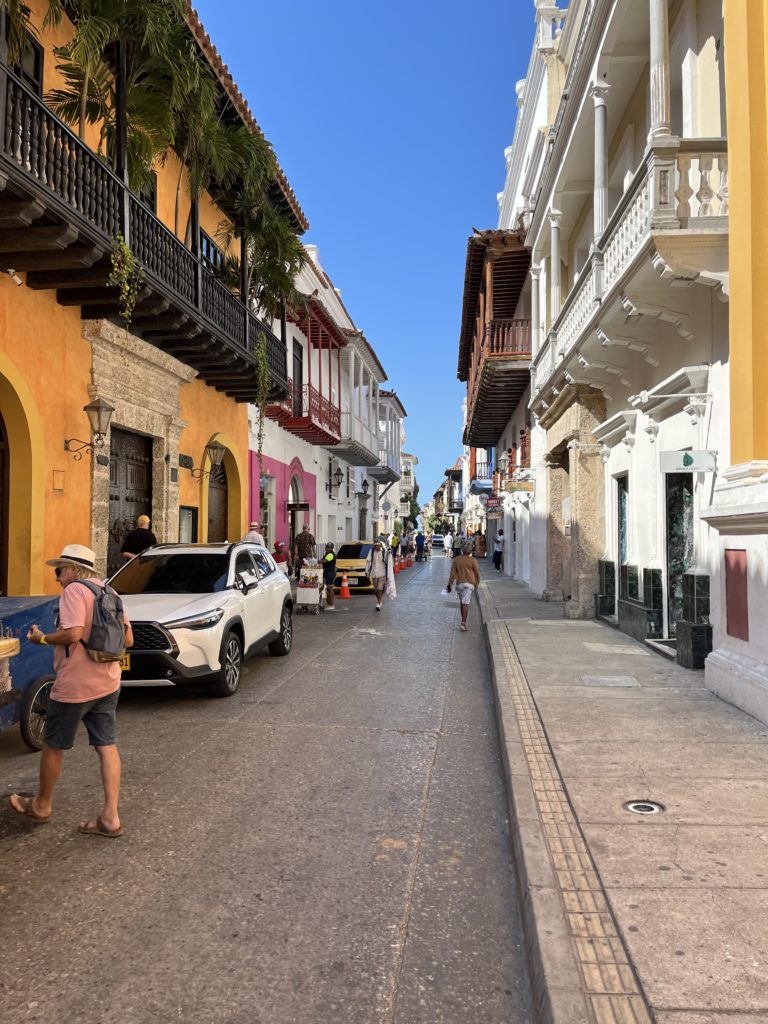
There is a lot to soak up; a great atmosphere; people are more off-hand here than in the other towns we have visited. It’s a busy tourist entrêpot and for the first time we have encountered the dreaded hawkers who, thankfully, are not as oppressively insistent as their counterparts in other parts of the world, notably Araby and India. It is so difficult to explain that I already have a hat, a T-shirt, fridge magnets – yadda yadda. Endless, cheaply made tchochkes usually in the worst taste and which Christoph calls Schnick-Schnack‘s . Far rather you pointed me in the direction of a good Margherita or Mojitos or a vacant taxi, my good man!
How poncey is that?!
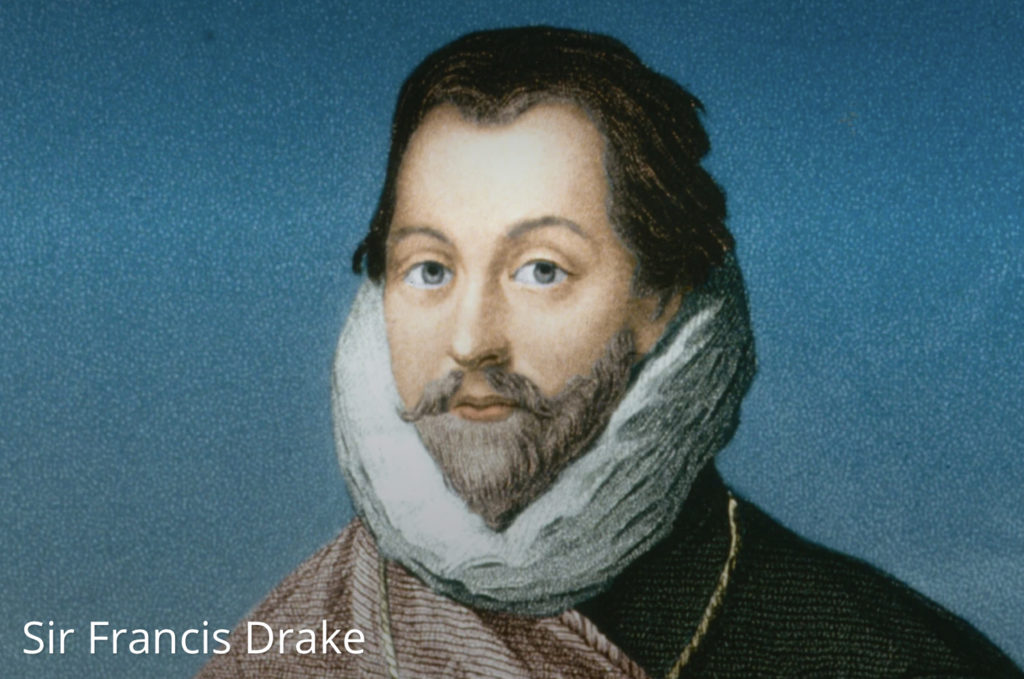
And what about this: my paternal grandmother was Cecily Cartwright née Drake. She claimed descent from one of the many Drake Brothers of whom Francis was the oldest. There were twelve of them. Poor Mrs. Drake had a torrid time of it. This would make Francis Drake a distant uncle but I am not sure how proud to be of this dubious fact bearing in mind the mayhem he caused in the Spanish colonies. He was basically a legalised pirate, slaver and plunderer of note. Forbes puts his wealth in today’s terms at $144,000,000 most of which came from his dubious deeds. He famously sacked and occupied Cartagena in 1586 in The Battle of Cartagena de Indias all in the name of Queen Elizabeth I who was at war with Philip II of Spain. I won’t mention what Drake did in Ireland else I’ll have no friends left.
José and Hans-Peter have flown down from Mesitas for a few days. They took us last night into the throbbing heart of the narrow streets of Getsemani, once murder alley but now far less edgier, where things are very lively, full of young people, and foodstalls, bars, clubs and street performers. Gentrification is on its way – a pressing issue for the district’s remaining citizens.
To-day, 25th February, we fly out of Colombia on the next stage of our journey, to visit our dear friend, Laura T in her island paradise at St. Barthélemy : usually just called St. Barts. Quite difficult to get to from here and entails a flight to Miami, a one night layover, a flight to the Dutch island of St. Maarten – or half of it at any rate – another layover, and finally the ferry to Gustavia. Laura thinks we are nuts but it should be intriguing.
More news from there, dear Friends All, and once again thank you for all your responses. Some of you have done very, very well in the multiple choice exams and seem to have at least enjoyed the pictures!
Pedro.
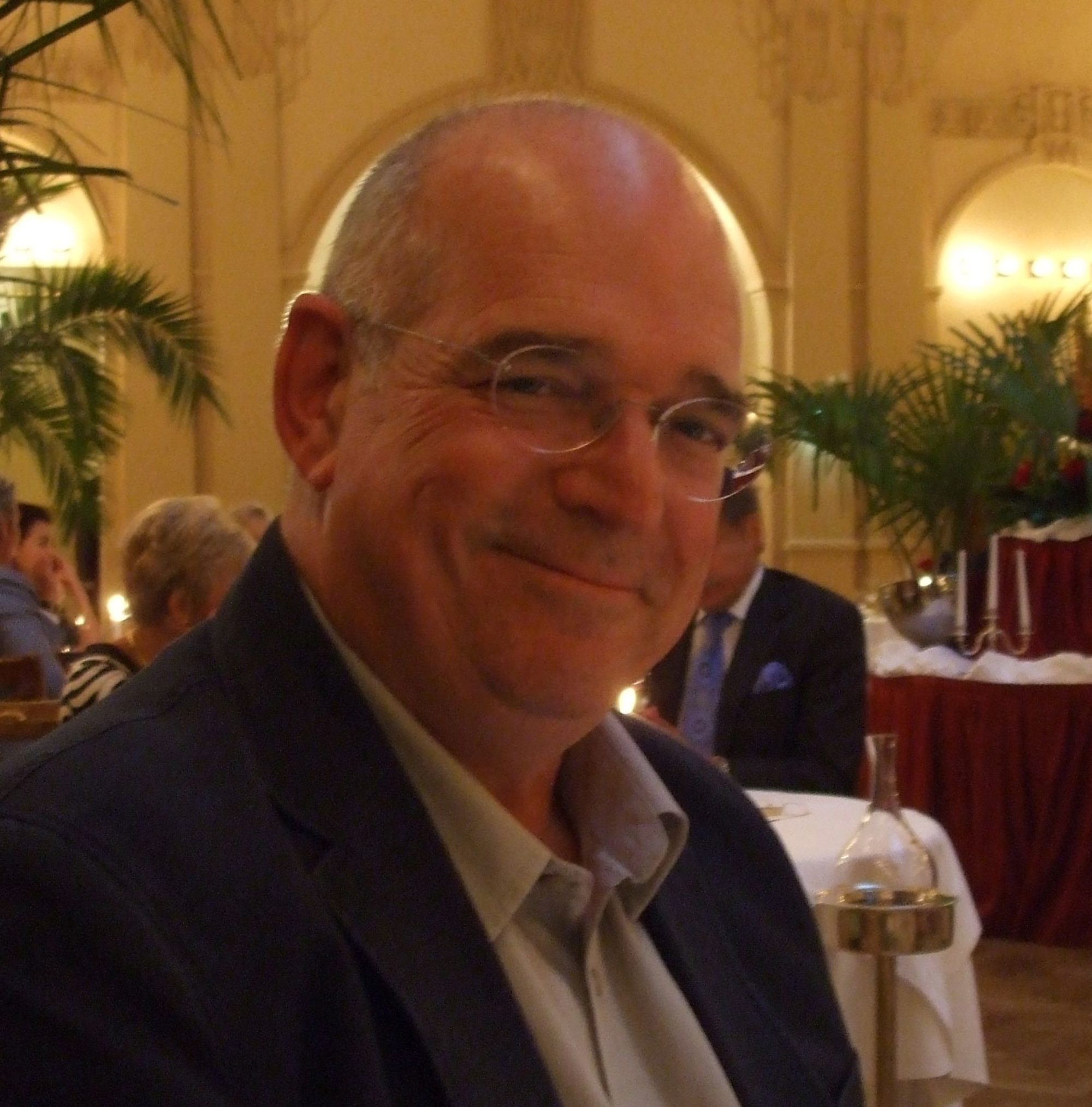
What a fascinating and colourful piece! Where next?? Is there anywhere left still to explore? Haven’t you hard the expression “there’s no place like home”? Your adventurous spirit puts me to shame. These days a trip to my local supermarket is an excursion!
Love,
Clive
All hail our intrepid explorers!! And bravo, Peter! Looks marvelous, but I’m with Stevenson and his donkey (less mosquitos, maybe?)
Love and huge hugs to you both,
Bonnie
Well done! Looking forward to the next episode, intrepid travellers! ❤️
What a fabulous trip you are having! Thank you for sharing. Can’t wait to hear about St Barts – you lucky ducks!
xxx
Really amazing! I love the videos as well as the photos. xx
What a trip. Enjoy the island with your friend Laura.
What a coincidence to see a photo of Sara Wheeler as I read her book Terra Incognita about her season in Antarctica. As usual, so much to make me jealous in this post.